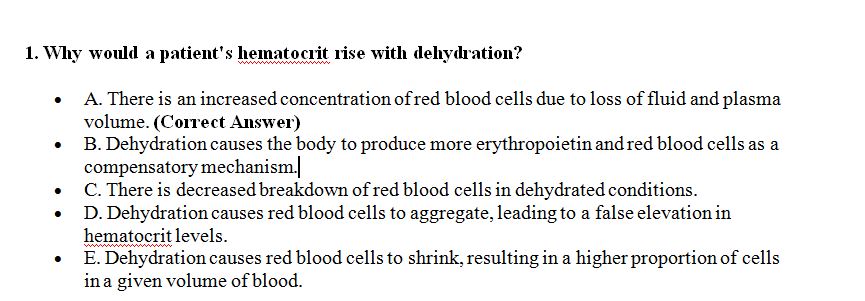- NURS6512 Week 3 Quiz: Why would a patient’s hematocrit rise with dehydration?
- A. There is an increased concentration of red blood cells due to loss of fluid and plasma volume.
- B. Dehydration causes the body to produce more erythropoietin and red blood cells as a compensatory mechanism.
- C. There is decreased breakdown of red blood cells in dehydrated conditions.
- D. Dehydration causes red blood cells to aggregate, leading to a false elevation in hematocrit levels.
- E. Dehydration causes red blood cells to shrink, resulting in a higher proportion of cells in a given volume of blood.
- How much is each unit of packed red blood cells (PRBCs) expected to raise the hematocrit level?
- A. Approximately 3%
- B. Approximately 19%
- C. Approximately 30%
- D. Approximately 9%
- Which of the following represent critical white blood cell (WBC) values for leukopenia and leukocytosis?
- A. < 500 and > 30,000
- B. < 5,000 and > 50,000
- C. > 500 and < 30,000
- D. < 4,000 and > 8,000
- Which of the following is NOT a cause of iron deficiency anemia in children?
- A. Thalassemia
- B. Inflammatory bowel disease
- C. Strict vegetarians
- D. Celiac disease
- E. Giardiasis
- The nurse practitioner responds to a patient who has disclosed that they are ready to discuss what has been bothering them by stating, “I am here and ready to listen.” Which therapeutic communication strategy is the NP displaying?
- A. Offering self
- B. Restating
- C. Focusing
- D. Silence
- When taking a history about sensitive material such as substance use or history of violence, which is the most appropriate approach?
- A. Request the patient to select among multiple options prepared on a form.
- B. Continuously persuade the patient to answer quickly to obtain the most reliable version of the events.
- C. Ask open-ended questions indirectly.
- D. Ask the patient to fill up a consent form to provide accurate information.
- E. Ask open and direct questions.
- When discussing cultural norms, what is the speaker advocating for in terms of individuals practicing their own traditions?
- A. Forcing individuals to assimilate into the dominant culture
- B. Prohibiting the practice of unique cultural traditions
- C. Embracing cultural differences and allowing individual practices
- D. Ignoring cultural differences for the sake of uniformity
- E. Asking the individuals to delay celebrating their cultural norms
- Which of the following answers best defines ethnicity?
- A. A group of people who share similar physical characteristics
- B. A group of people who all live in the same neighborhood
- C. A social group characterized by distinctive social and cultural tradition maintained from generation to generation (
- D. A group of people who share the same skin tone
- E. A group of people who are most genetically similar to one another
- When obtaining a history from a patient, which of the following should the clinician avoid?
- A. Inquiring into more than 2 symptoms with 1 question
- B. Incorporating a mix of open- and close-ended questions
- C. Asking the patient directly what diagnosis they think they have
- D. Starting the discussion with open-ended questions
- E. Using “continuers” while the patient tells their story
- In a survey of internal medicine faculty and residents, what aspect of a patient-doctor interaction did most believe was of greatest importance in making an accurate diagnosis?
- A. Body language
- B. Physical examination
- C. Laboratory tests
- D. History
- E. Imaging studies. More quizzes on this course
Answer Guide:NURS6512 Week 3 Quiz:

Unlock the Full Solution Now – Click to Get All Answers!”
NURS6512 Week 3 Quiz: